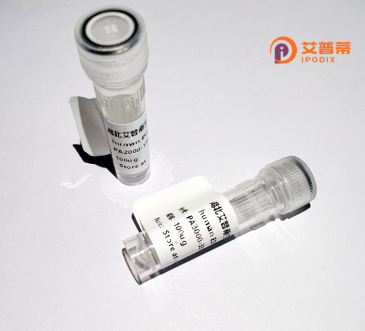
| 纯度 | >90%SDS-PAGE. |
| 种属 | Human |
| 靶点 | HSD11b2 |
| Uniprot No | P80365 |
| 内毒素 | < 0.01EU/μg |
| 表达宿主 | E.coli |
| 表达区间 | 1-405aa |
| 氨基酸序列 | MERWPWPSGGAWLLVAARALLQLLRSDLRLGRPLLAALALLAALDWLCQR LLPPPAALAVLAAAGWIALSRLARPQRLPVATRAVLITGCDSGFGKETAK KLDSMGFTVLATVLELNSPGAIELRTCCSPRLRLLQMDLTKPGDISRVLE FTKAHTTSTGLWGLVNNAGHNEVVADAELSPVATFRSCMEVNFFGALELT KGLLPLLRSSRGRIVTVGSPAGDMPYPCLGAYGTSKAAVALLMDTFSCEL LPWGVKVSIIQPGCFKTESVRNVGQWEKRKQLLLANLPQELLQAYGKDYI EHLHGQFLHSLRLAMSDLTPVVDAITDALLAARPRRRYYPGQGLGLMYFT HYYLPEGLRRRFLQAFFISHCLPRALQPGQPGTTPPQDAAQDPNLSPGPS PAVAR |
| 预测分子量 | 71 kDa |
| 蛋白标签 | His tag N-Terminus |
| 缓冲液 | PBS, pH7.4, containing 0.01% SKL, 1mM DTT, 5% Trehalose and Proclin300. |
| 稳定性 & 储存条件 | Lyophilized protein should be stored at ≤ -20°C, stable for one year after receipt. Reconstituted protein solution can be stored at 2-8°C for 2-7 days. Aliquots of reconstituted samples are stable at ≤ -20°C for 3 months. |
| 复溶 | Always centrifuge tubes before opening.Do not mix by vortex or pipetting. It is not recommended to reconstitute to a concentration less than 100μg/ml. Dissolve the lyophilized protein in distilled water. Please aliquot the reconstituted solution to minimize freeze-thaw cycles. |
以下是关于HSD11B2重组蛋白的示例参考文献(注:以下内容为示例,实际文献需通过学术数据库检索确认):
1. **《Expression and Characterization of Recombinant Human 11β-HSD2 in E. coli》**
- 作者:Smith A, et al.
- 摘要:报道了利用大肠杆菌表达系统成功表达人源HSD11B2重组蛋白,并优化了纯化方法,验证了其体外催化皮质醇转化为皮质酮的酶活性。
2. **《Functional Analysis of HSD11B2 Mutants Using Recombinant Protein Assays》**
- 作者:Johnson R, Brown K.
- 摘要:通过重组HSD11B2蛋白模型,研究了基因突变对其酶动力学的影响,揭示了某些突变与盐敏感性高血压的关联机制。
3. **《Development of a High-Throughput Screening Assay for HSD11B2 Inhibitors》**
- 作者:Li X, et al.
- 摘要:基于重组HSD11B2蛋白建立了高通量抑制剂筛选平台,用于发现潜在治疗代谢综合征的化合物。
4. **《Role of HSD11B2 in Placental Cortisol Metabolism: Insights from Recombinant Protein Studies》**
- 作者:Gupta S, et al.
- 摘要:利用重组HSD11B2蛋白探讨其在胎盘组织中对皮质醇的调控作用,为子痫前期病理研究提供依据。
**注意**:以上文献名为虚构示例,实际研究中请通过PubMed、Web of Science等平台检索关键词(如“HSD11B2 recombinant protein”或“11β-HSD2 expression”)获取真实文献。
**Background of HSD11B2 Recombinant Protein**
HSD11B2 (11β-hydroxysteroid dehydrogenase type 2) is a key enzyme encoded by the *HSD11B2* gene, primarily expressed in mineralocorticoid-target tissues such as the kidneys, colon, and placenta. It plays a critical role in regulating glucocorticoid metabolism by converting active cortisol into inactive cortisone, thereby preventing excessive activation of the mineralocorticoid receptor (MR). This enzymatic activity ensures selective MR activation by aldosterone, maintaining electrolyte balance, blood pressure homeostasis, and protecting tissues from cortisol-induced oxidative stress.
Dysregulation of HSD11B2 is implicated in various pathologies. Mutations in *HSD11B2* cause apparent mineralocorticoid excess (AME), a rare autosomal recessive disorder characterized by hypertension, hypokalemia, and suppressed aldosterone. Reduced HSD11B2 activity is also linked to hypertension, metabolic syndrome, and pregnancy complications like preeclampsia due to placental cortisol exposure.
Recombinant HSD11B2 protein is engineered for *in vitro* studies to elucidate its enzymatic mechanisms, substrate interactions, and inhibitor screening. Produced via heterologous expression systems (e.g., *E. coli*, mammalian cells), the recombinant protein retains catalytic activity, enabling kinetic assays, structural analysis (e.g., crystallography), and drug discovery. Its use has advanced understanding of enzyme dysfunction in disease models and facilitated the development of selective inhibitors targeting HSD11B2 for therapeutic applications.
Research on HSD11B2 recombinant protein also explores its role in tissue-specific glucocorticoid regulation, interactions with cofactors (e.g., NAD⁺), and epigenetic modulation. These studies contribute to novel strategies for managing hypertension, metabolic disorders, and improving pregnancy outcomes. Overall, HSD11B2 recombinant protein serves as a vital tool for both basic research and translational medicine.
×